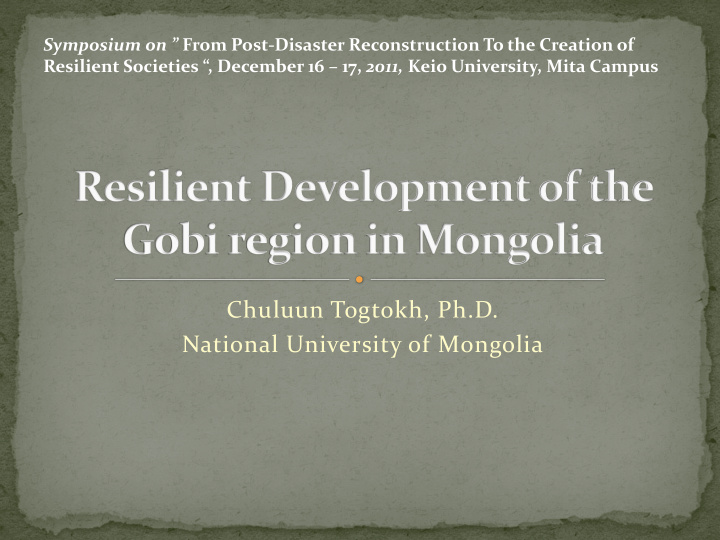



Symposium on ” From Post-Disaster Reconstruction To the Creation of Resilient Societies “, December 16 – 17, 2011, Keio University, Mita Campus Chuluun Togtokh, Ph.D. National University of Mongolia
Introduction Vulnerability of pastoral social-ecological systems Ecoregion-based adaptation
Mongolia as an open complex system Mongolia is viewed as a complex system, consisted of Economic interconnected political, economic, social, ecological and cultural subsystems as five main organs of the organism, Political Social interconnected through father-son and friend-enemy connections (as in folk medicine). For Mongolia’s health it is essential to have healthy subsystems. Mongolia made transition to democracy and Environmental Culture market economy 2 decades ago, becoming an open system to world policy, markets, western and other cultures, religion, knowledge , technology and global environmental impacts.
L. Natsagdorj, 2008
Vulnerability and resilience of Dryland Sustainability social-ecological systems Institute T. Chuluun, River basin Community National M. Altanbagana S. Davaanyam B.Tserenchunt
Drought Climate change factor Ecological Vulnerability Drought+zud Human Pasture use factor Socio-Economic Vulnerability Vulnerability of social- ecological system
vulnerability dynamics Long-term ecological in Mongolia 1970-1990 0.30 0.40 0.50 0.60 1970 1972 1974 1976 1978 1980 1982 1984 1991-2008 1986 1988 1990 1992 1994 1996 1998 2000 2002 2004 2006 2008
Vulnerability assessment of social- ecological systems at aimag level Huvsgul Uvs Bayan- Ulgii Selenge Dornod Bulgan Hovd Zavhan Hentii Tuv Arhangai Suhbaatar Uvurhangai Govi-Altai Baynahong Dundgovi or Dornogovi N Umnugovi LEGEND < 0.25 0.26 - 0.35 W E 0.36 - 0.45 0.46 - 0.55 S 0.56 < No data Social-ecological vulnerability = ecological vulnerability + poverty indexes (UNDP) Chuluun, T. 2011. Land degradation and desertification in Mongolia. Background paper for the Mongolia Human Development Report 2011.
Rich Sustainable transformation “ W estern” m odels W in-W in Farms/ ranches with CIT & renewable energy Rich herders (~ 10% ) Strengthening of traditional Human Well-being “ Hot ails ” pastoral networks with modern technology Tragedy of Com m ons Traditional System Weak cooperation Strong cooperation Landscape fragmentation Cultural landscape use Land degradation Ecosystem state is good Poverty trap (~ 40% ) Subsistence (~ 50% ) Loss of adaptive capacity to climate Poor variability Weak/ Strong/ Cooperation (CBNRM) Low Good Use of cultural landscape/State of ecosystem ACCCA project services
Win-Win Adaptation (Ecosystem Services & Biodiversity) (Innovation, Ecological Resilience Science & Technology) Collapse Social Resilience (Equity, Institution, Leadership, Cooperation & Trust)
Mongolia is becoming more vulnerable to climate change due to its impacts on water and forage resources, and also transitional economy; Many “big” projects were often fragmented, not enhancing both social and ecological resilience ; Eco-region based adaptation: Adaptation policy must be diverse in different ecological zones; • Transformation opportunity of social-ecological systems, using adaptation science and technologies in Mongolia.
The Mongolian Gobi The world fastest growing economy The highest social-ecological vulnerability in Mongola Globally Important Agricultural Heritage System World Natural and Cultural Heritage System Innovation in technology (RE, CIT etc.) Institution & Policy
Thank you! Bayarlalaa! Arigatou Gozaimashita!
Recommend
More recommend